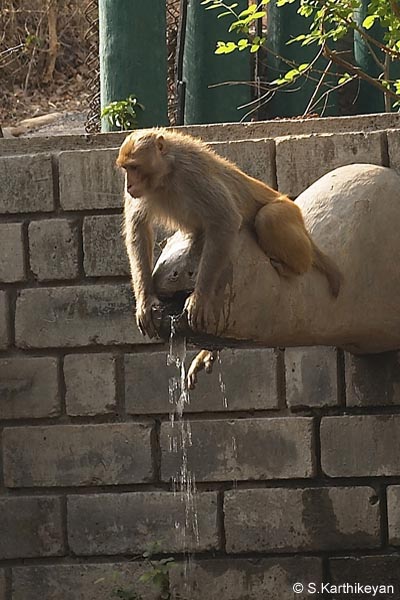For quite sometime to come, May 11-21, 2006 will remain the most memorable days of my life. The places that I visited were all only names in my mind, albeit, a hope of visiting these places at some future date was always there. On this trip I was accompanied by my colleague.
May 11, 2006, it was well past lunch time when I stepped out of the aircraft at the Jammu airport to be hit by a blast of hot air. The temperature outside was 43.6 ˚C. The high temperatures did take me by surprise. One always imagines that the temperatures here were always very pleasant. This was just the beginning of the trip.
The heat was quite sapping. However, the Brown Rock Chat, Redvented Bulbul, Magpie Robin, Brahminy Myna to name a few seemed oblivious to the heat. A Himlayan Bulbul was bold to visit a small garden within the hotel building and was comfortable perching on the lampshades.
On 12th May, 2006, we visited the Ramnagar Wildlife Sanctuary on the outskirts of the city and did some birding. The only bird worthy of a special mention is the Rustycheeked Scimitar Babbler. I had seen this bird near Nainital last December. We also saw the Red Junglefowl, Alexandrine Parakeet, Yellowthroated Sparrow, Thickbilled Flowerpecker and Bluethroated Flycatcher to mention a few. During our walk through the sparse forests of Ramnagar WLS, we stopped at a watering point. Morning walkers and wildlife seemed to use this water source. My attention was drawn to the wasps that seemed to be drinking from the wet soil. While I was showering attention on these wasps, I had completely ignored the Rhesus Macaques that were waiting for their turn to have a drink.
Later in the day we went to a town called Aknur (4 km. as the crow flies from Pakistan border!) on the banks of River Chenaub. We also visited Surinsar a small wetland on the morning of 13th May 2006, some 26 km. from Jammu. We rushed back from there to the hotel and on to the airport.
During the stay at Jammu, we saw some birds, butterflies besides the Rhesus Macaque and the Barking Deer. The stay at Jammu did not yield any lifer.
Jammu airport was very chaotic. Everything seemed to take a long time. The security people made a big fuss about the batteries that I was carrying. They had to confiscate the same and I was told that it would be returned to me at Srinagar airport. Fortunately, they did.
Look in any direction standing at the Srinagar airport, and you will see snow-clad mountains. It was a beautiful sight. The plants, both wild and cultivated, were in bloom adding colour to the already pretty settings. We went straight to the Hokarsar wetland. This is a Ramsar Site. It is visited by over 6 lakh birds during the season. This is perhaps one of the most beautiful wetlands that I have seen. Being the wrong season, did not see many birds. The Jackdaw, however seemed to be common. The Yellow (Citrine) Wagtail in full breeding dress was a sight to behold. Having spent a few hours, we went straight to Dachigam National Park, the place where we were to stay for 2 nights. It was getting dark when we reached Dachigam. However, not before we could briefly stop to get some pictures of the Dal Lake. We settled down in the guest house, had dinner and went off to sleep.
At 5.30 am. we went out for some birding the following morning. I was immediately treated to the lovely sight – the Yellowbilled Blue Magpie. It was as pretty as its counterpart, the Redbilled Blue Magpie, which I had seen during a trip to Nainital during December 2005. This was followed by the Variegated Laughing Thrush. But through the morning one call was haunting me. I tried to locate the bird, but in vain. We were almost back at the guest house when a little nondescript brown bird showed itself. While watching the bird, it also uttered the call – yes, the same haunting call. It turned out to be the Brownish-flanked Bush Warbler – another lifer. Other lifers were Chestnuteared Bunting and Eurasian Cuckoo.
Post breakfast, we were on our way to Pahalgam. The 90 or so kilometre drive was through very scenic and beautiful landscapes. Part of the drive was along River Lidder and through the Aru Wildlife Sanctuary which is contiguous with the Dachigam National Park. There was not much of an opportunity for birding. However, we stopped often to take pictures of the fast flowing river and the snow-clad mountains.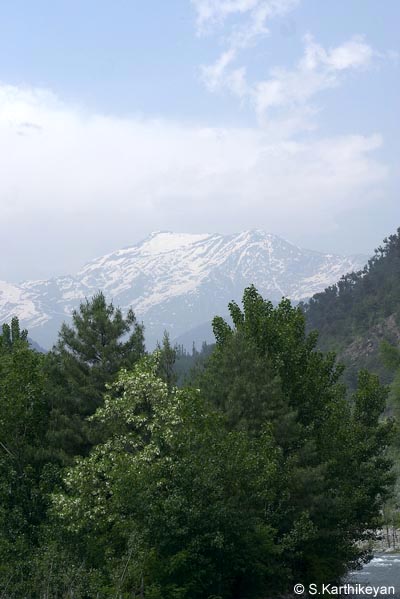
The next morning I was out very early hoping to do some decent birding. As I stepped out of the guest house, I was greeted by the calls of the Brownish-flanked Bush Warbler. The morning was chill. The hill sides were beautiful with wild roses in bloom. There was not much bird activity. The best sighting of the morning was the Kashmir Flycatcher. The male singing is what gave away its presence. The bright red on the front edged on the sides with black was handsome. I had seen this bird way back in a shola near Ooty (in 1989 December – from memory!). The Speckled Wood Pigeon and the Sind Sparrow that I saw were lifers. The morning also saw me lavishing some time to photographing the wild flowers that seemed to be all over.
We walked back to the guest house in time for breakfast. We were told that the Srinagar-Leh road had been opened. The morning had become bright and sunny bringing out all the butterflies. In between mouthfuls, I managed to get some decent shots. Some were also lifers for me. The Black Bulbuls were constant company. They were seen flying around and constantly calling.
A little disappointed at inadequate birding and not seeing either the Hangul or the Himalayan Black Bear, we packed and left to Srinagar. After a little delay, we started on our journey to Leh around afternoon.
We planned to cover the distance of about 430 km. over two days.
First day: Srinagar – Sonmarg – Dras – Kargil; Second day: Kargil – Lamayuru -Leh
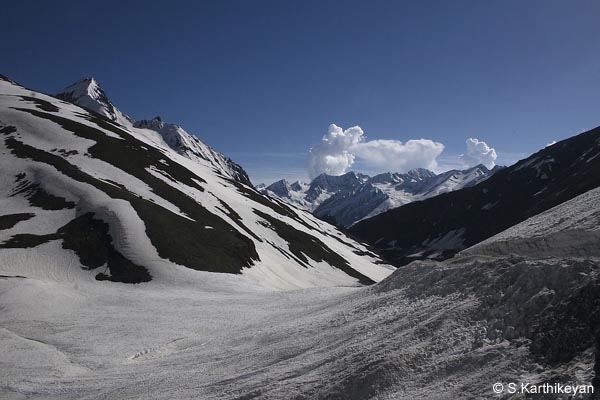
On the first day, we drove via Sonmarg and Dras to Kargil. The road took us through some beautiful landscapes. In some places the road was treacherous. However, after finding out that the driver has been driving on this route for several years, we became oblivious to the road and concentrated on the landscape and the odd bird that we spotted. The Magpie, Yellowbilled Chough, Redbilled Chough, Plumbeous Redstart, Black Redstart Rock Bunting, Himalayan Whistling Thrush and the Rosy Pipit were the birds that we saw. The Rosy Pipit was the only lifer. Closer to Zojila (at about 11500 ft.) there were snow-cutting and earth-moving equipment parked on the road sides. They had just finished working and had enabled traffic to ply on this road. The landscape changed after we traversed the pass. The tree draped hills gave way to more barren terrain. We passed Dras – a quaint little hamlet – before reaching Kargil. It is believed that Dras is the second coldest place on Earth. At Kargil, we stayed at the Circuit House for the night.
To see more trip pics click here
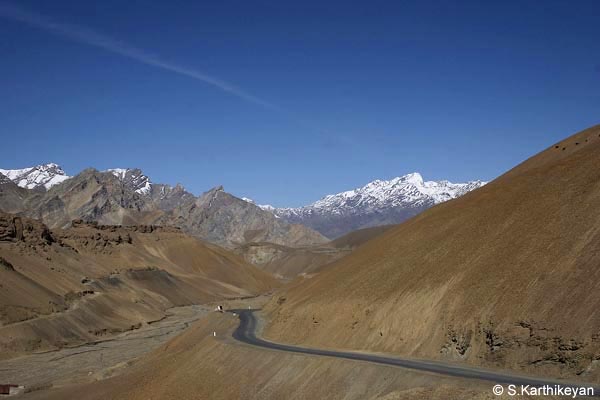
The next morning (16th May 2006), after an early breakfast we left Kargil. We traversed mile after mile of barren mountainous terrain. A hint of greenery was seen when we passed a village. We soon reached Fotula (about 13,000 ft.) the highest point on the Srinigar-Leh Road. We briefly stopped at Lamayuru before continuing our drive to Leh.
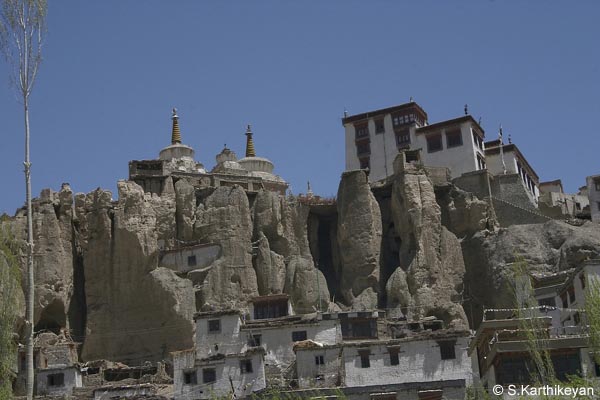
On route, we saw both the Redbilled and the Yellowbilled Choughs on several occasions. These seemed to be the high altitude scavengers replacing the crows of the lower altitudes. The Black Redstarts were common along the rivers. We did stop to get a good look the odd bird and to take pictures of the scenery. On one such instance we stopped to take pictures of the Hill Pigeon resting on a rocky outcrop. And near a village, our driver (who by now had understood our interests) suddenly stopped and pointed out at a bird on a rubble wall – a Chukar Partridge! The bird just gave two frames.
We arrived at Leh and settled in our room in the guest house that was booked for us. Mongolian Finch and the Variable Wheatear were the lifers on this drive. We reached Leh towards evening and checked-in to the guest house that was booked for us.
We were advised to rest during the evening and the following day. The next morning we ventured out briefly in the morning hoping to see some birds. We went to a nearby small wetland where we saw the Wigeon, Common Pochard, Shoveller, Coot, Tufted Duck, Citrine Wagtail and the House Sparrow. We took it easy during the rest of the day.
On 18th May 2006, it was suggested that we drive up to Khardungla – the highest motorable in the world! The drive was a very good experience. It also yielded my first high altitude mammal – the Himalayan Marmot, Also a couple of lifers among birds – Alpine Accentor, Horned Lark and Brandt’s Mountain Finch. One could see how the vegetation changed as one went higher. Also, the weather was very fickle. It would be sunny for a while and suddenly you have clouds and fine snowflakes descending upon you. I was not prepared for the cold up there. With a denim jacket to protect me I took in the beautiful landscapes and also took some pictures. The temperature at noon was -5 ˚C. There were icicles hanging from the roof of the small canteen that served some hot coffee. We happily gulped down 2 cups apiece. I also had my colleague take a picture of myself near the board that said “Khardungla – the highest motorable road in the world – 18380 ft.” This was the only picture which featured me during the entire trip.
Tso Moriri, a high altitude wetland located at about 14800 ft. was on the list of places that we had to visit. So, on May 19, 2006 post breakfast, we left for Tso Moriri. Well past Thykse we spotted a herd of Urial (locally called the Shaapu) a little away from the road. On seeing our vehicle they slowly started moving away. However, it was enough time to get a few pictures. Before we reached Chumathang, I spotted two Blue Sheep on the steep cliffs. We stopped and took several pictures. Two individuals stood on the edge of a rock and were watching us. It seemed as if they were as interested in seeing us as we were in seeing them.
River Indus flows along the road almost from the time you leave Leh till you reach the Mahe Bridge. In the river we saw a pair of Common Mergansers and also a Brahminy Duck. Seeing the Brahminy Duck in its breeding grounds was exciting. We later spotted a pair of these birds sitting high up on a cliff – nesting perhaps?
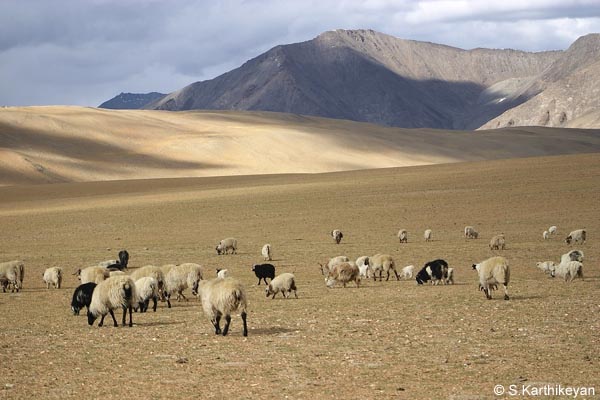
We drove past a few tents of the nomads grazing their sheep on a couple of occasions. As we came closer to Tso Moriri we were stopped by Indo Tibetan Border Police who briefly spoke to us and let us pass. We crossed the camp of the ITBP and reached Karzok village. We were accorded a warm welcome with a thin silk scarf put around our neck. We had some hot tea and decided to walk along the shores of Tso Moriri. We must have spent some half hour walking the shores taking some pictures of the landscapes which seemed to change often. It also started to get cold – the cold getting to the bone. We quickly started walking back to the place of stay in the village. The horses were also walking back after grazing. We had dinner and went to sleep. The night was cold. I thought the discomfort caused by the cold would keep me awake. Fortunately, there was enough protection to keep the cold at bay. However, the constant discussion of the horses and the donkeys woke me up from time to time.
The morning saw us get ready for another walk along the shores after a hot and welcome cuppa. We set out to do some birding. I saw a small flock of birds on the ground. From a distance, they looked like large well-fed pigeons. When we approached them, we realised that they were sandgrouses. We got a good look at the bird and they turned out to be the Tibetan Sandgrouse. I also managed some record shots of the bird.
An hour must have passed, we slowly made our way back and towards the breakfast table. After breakfast, we went to the monastery in the Karzok village for an interaction with the villagers. During the interactions, my attention was constantly being distracted by the flock of Brandt’s Mountain Finch. While there, we were treated to very sparse snowfall. It was such a beautiful experience to end our stay at the village. We hurriedly had lunch and got into the jeep to head back to Leh.
The weather was quite bad. It was cloudy and some sleet coming down. We had perhaps traversed some 20 km. Suddenly, we heard a sound and we realised that we had a flat. We were in the middle of nowhere. We searched for the jack, found it and changed the tyre. Fortunately, when we were about finished, another vehicle drove up and stopped behind us. They helped put away the tyre with a flat and we drove on. I was so relieved to have another vehicle behind us. We had to reach Leh on that night itself as we had an early morning flight back to Delhi. When we reached Upshe, we were hungry. At a roadside hotel, we gobbled up some hot noodles and washed it down with some black tea before continuing our drive to Leh.
We reached Leh late evening, quickly freshened up, repacked and had dinner. This more or less brought to an end our trip to the northern most part of India. We got up early in the morning and we were quickly on our way to the airport. The flight took off and we were treated to one of the most beautiful spectacles that one can ever see. The vast expanse of snow-clad mountains as far as the eye could see left a deep mark in our minds. Before we realised, we were in Delhi which came as a rude shock after spending ten days in some of the most beautiful and pristine areas on earth.
Jammu, Srinigar, Kargil, Dras, Leh, River Tawi. River Chenaub, River Lidder, River Suru, River Indus, Tso Moriri, and Khardungla were all only names until this trip. It will be a trip that I will not forget in a long time to come.
To see more trip pics click here.
